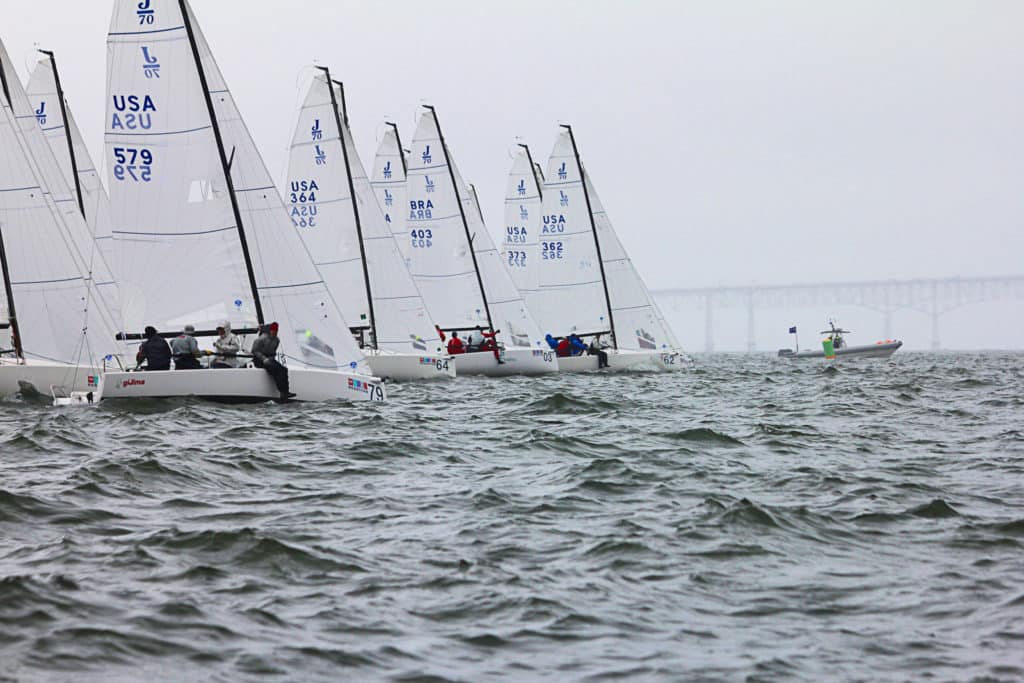
Now that you’ve been on the racecourse collecting data for an hour (you have been, right?) it’s time to make a game plan. It’s essential to have a plan, even if it turns out to be wrong. It allows the whole team to focus on an objective, and in the heat of the moment, when quick decisions are necessary, the game plan serves as a guiding light. If you take the “wing it and see what happens” approach, I guarantee you’ll be indecisive when it really counts.
When making a plan, factor in all of the data you have been observing before the race. First and foremost, you’ll want to put a lot of emphasis on taking advantage of the favored end of the starting line. The race will be much easier if you’re ahead early. At one point during my 470 Olympic campaign, I was having a tough time starting so I asked eventual gold medalist Paul Foerster, who had dominated a regatta, what he thought about when deciding where to start. “I start near the favored end,” he replied. As I walked away I felt very foolish for asking, but it really is that simple: make it a priority.
In addition to starting near the favored end, you need to sail toward whatever racecourse features you think will help you the most tactically, and most immediately. This is, of course, one of the main reasons you got to the racecourse an hour before the start and tuned up and down a few times. During that time you should have gotten a feel for the conditions and started to notice what was important, relative to the wind and current. You will find that, most of the time, sailing in more wind and sailing toward the mark are the main factors that help you do well, especially in extreme cases. But sometimes other factors must be given priority, especially when the wind velocity and direction are steady. Sometimes, sailing toward favorable current or a geographic shift makes it to the top of your plan. And sometimes it’s a mix of factors that will end up working best, such as playing the shifts while working toward a side for favorable current.
Let’s say you observed that it is really shifty, so your best plan is to get a good start and sail the lifted tack. Or maybe you noticed there was always more wind on the left, so your best plan is to get a good start and sail left. Or maybe you know the tide is a huge factor, so your best plan is to get a good start and play the tide. Each race is different and that is what makes sailing so much fun.
Sometimes your plan can be modified at the last second, especially if something significant changes, such as the favored end changing due to a big wind shift or even the favored end becoming so crowded you deem it too high risk.
I will never forget the second race of the 2008 Etchells World Championship in Chicago. It was the first race of the day and we determined there was more wind offshore, which was left, facing upwind. Our plan was to start at the pin end and go left for more pressure. As we set up for the pin on our port-tack approach, skipper Bill Hardesty called an audible. Rather than tacking into a hole near the pin he kept sailing and said, “the guys down here will fight to the death for the pin and we don’t want any part of that.”
As the clock was winding down, we found a hole further up the line and had a clean start about one-third of the way up the line. The yelling and screaming coming from the pin end after the start was music to our ears. I looked under the boom to see three boats head-to-wind at the pin, one of them hung up on the anchor line. Our lane turned out to be perfect, and mixed with good boatspeed, we were able to hit the left hard, and win the race.
We did the same thing the next race as well and those two bullets did everything for our scores and confidence to win the event. The takeaway for me was that Bill had the foresight—based on his knowledge of those competitors—to understand that executing our original plan was going to be very risky. He modified the plan in the final two minutes to increase our chances of sailing clean toward the left side, which was more important than winning the pin. The key is to have a solid plan, based on pre-race research, that will guide your decisions early in the race.
Before the race starts, verbalize your plan to the team. Involving all crewmembers is a great way to get everyone on the same page. It can also help you consider some tactical factors you may have not considered. Another benefit of discussing the plan with the group is that it helps others buy in to the plan, which brings everyone together and helps the team anticipate future moves.
With a game plan in hand, you can start working on the nuts and bolts of getting a great start









